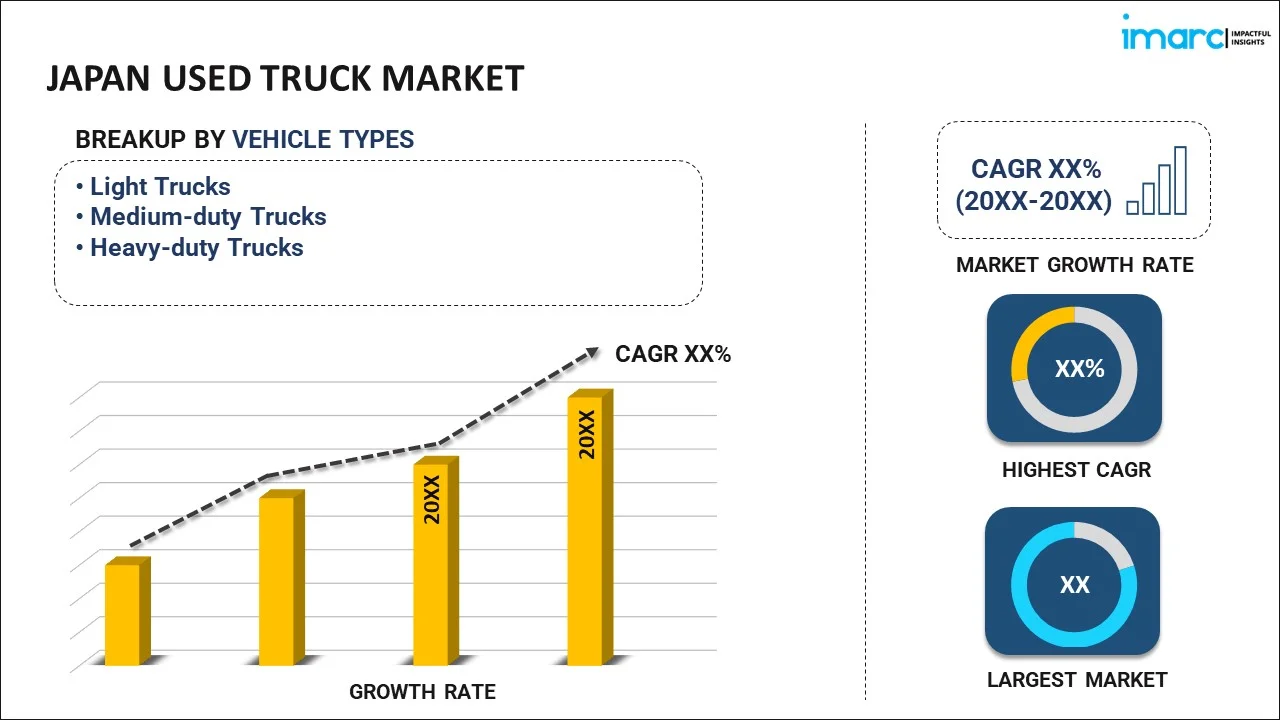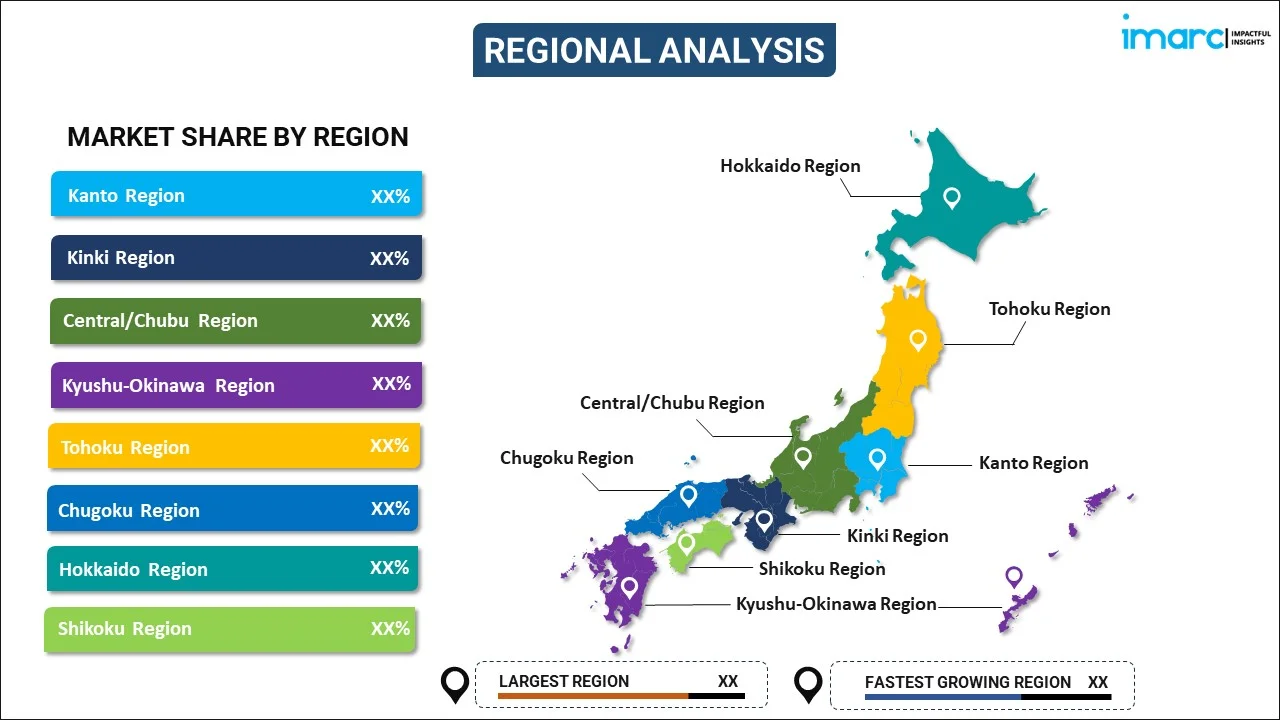
Japan Used Truck Market Report by Vehicle Type (Light Trucks, Medium-duty Trucks, Heavy-duty Trucks), Sales Channel (Franchised Dealer, Independent Dealer, Peer-to-Peer), End User (Construction, Oil and Gas, and Others), and Region 2025-2033
Market Overview:
The Japan used truck market size reached USD 1.3 Billion in 2024. Looking forward, IMARC Group expects the market to reach USD 1.9 Billion by 2033, exhibiting a growth rate (CAGR) of 3.7% during 2025-2033. The rapid industrialization activities, imposition of stringent regulations by the Government of Japan, widespread vehicle utilization by e-commerce and retail businesses, the emerging trend of green consumerism, and the recent technological advancements represent some of the key factors driving the market.
|
Report Attribute
|
Key Statistics
|
|---|---|
|
Base Year
|
2024 |
|
Forecast Years
|
2025-2033
|
|
Historical Years
|
2019-2024
|
| Market Size in 2024 | USD 1.3 Billion |
| Market Forecast in 2033 | USD 1.9 Billion |
| Market Growth Rate (2025-2033) | 3.7% |
A used truck is defined as a commercial vehicle that has been previously owned, serving various purposes, including transportation and other business-centric activities. These vehicles are subjected to rigorous evaluations to determine their state, focusing on key components such as the engine, transmission, brakes, suspension, bodywork, and interior. They are used in a wide spectrum of applications, such as construction, agriculture, mining, freight transport, logistics, forestry, retail delivery, and specialized areas, including oil and gas transportation, military support, public transportation, refrigerated goods, towing, and mobile business platforms. Used trucks offer multiple benefits, such as a reduction in initial purchase cost, immediate availability, known performance history, customization potential, decreased depreciation, a broad selection range, and the existence of warranty options. They also come with flexible financing solutions, opportunities for insurance cost reduction, and possible tax incentives. As compared to new trucks, used trucks offer various advantages, such as practicality for short-term needs, simplified resale procedures, adaptability across diverse industrial sectors, contribution to sustainability via reuse, access to certified pre-owned selections, professional-grade inspection assurances, minimized total lifecycle expenses, and compatibility with fiscal limitations.
Japan Used Truck Market Trends:
The resurgence of industrial activities and rapid urbanization in Japan, which has increased the demand for transportation solutions, is propelling the market growth. Additionally, the imposition of stringent regulations by the Government of Japan promoting the recycling and reutilization of vehicles is acting as another growth-inducing factor. Furthermore, widespread vehicle utilization as an economical and viable solution by e-commerce and retail businesses for logistics and freight services is contributing to the market growth. Apart from this, the emerging trend of green consumerism in Japan, which is encouraging the adoption of used trucks as a sustainable choice that reduces carbon footprint and supports environmental preservation, is positively influencing the market growth. Besides this, the recent technological advancements, such as the integration of advanced, fuel-efficient engines in used trucks, which aligns with the shifting trend towards eco-friendly transportation, are supporting the market growth. Moreover, the growing vehicle adoption in transportation and construction activities due to increasing investment in infrastructure projects is catalyzing the market growth. In addition to this, the versatility of used trucks, as they are capable of being customized to suit various industry needs, such as mining, waste management, military support, and emergency services, is favoring the market growth. Other factors, including the availability of flexible financing options and lower insurance premiums, the introduction of professional inspections and certifications associated with used trucks, and increasing emphasis on sustainability, are anticipated to drive the market growth.
Japan Used Truck Market Segmentation:
IMARC Group provides an analysis of the key trends in each segment of the Japan used truck market report, along with forecasts at the country level for 2025-2033. Our report has categorized the market based on vehicle type, sales channel, and end user.
Vehicle Type Insights:

- Light Trucks
- Medium-duty Trucks
- Heavy-duty Trucks
The report has provided a detailed breakup and analysis of the market based on the vehicle type. This includes light trucks, medium-duty trucks, and heavy-duty trucks.
Sales Channel Insights:
- Franchised Dealer
- Independent Dealer
- Peer-to-Peer
A detailed breakup and analysis of the market based on the sales channel has also been provided in the report. This includes franchised dealer, independent dealer, and peer-to-peer.
End User Insights:
- Construction
- Oil and Gas
- Others
A detailed breakup and analysis of the market based on the end user has also been provided in the report. This includes construction, oil and gas, and others.
Regional Insights:

- Kanto Region
- Kinki Region
- Central/Chubu Region
- Kyushu-Okinawa Region
- Tohoku Region
- Chugoku Region
- Hokkaido Region
- Shikoku Region
The report has also provided a comprehensive analysis of all the major regional markets, which include Kanto Region, Kinki Region, Central/Chubu Region, Kyushu-Okinawa Region, Tohoku Region, Chugoku Region, Hokkaido Region, and Shikoku Region.
Competitive Landscape:
The report has also provided a comprehensive analysis of the competitive landscape in the market. Competitive analysis such as market structure, key player positioning, top winning strategies, competitive dashboard, and company evaluation quadrant has been covered in the report. Also, detailed profiles of all major companies have been provided.
Japan Used Truck Market Report Coverage:
| Report Features | Details |
|---|---|
| Base Year of the Analysis | 2024 |
| Historical Period | 2019-2024 |
| Forecast Period | 2025-2033 |
| Units | Billion USD |
| Scope of the Report | Exploration of Historical and Forecast Trends, Industry Catalysts and Challenges, Segment-Wise Historical and Predictive Market Assessment:
|
| Vehicle Types Covered | Light Trucks, Medium-duty Trucks, Heavy-duty Trucks |
| Sales Channels Covered | Franchised Dealer, Independent Dealer, Peer-to-Peer |
| End Users Covered | Construction, Oil and Gas, Others |
| Regions Covered | Kanto Region, Kinki Region, Central/Chubu Region, Kyushu/Okinawa Region, Tohoku Region, Chugoku Region, Hokkaido Region, Shikoku Region. |
| Customization Scope | 10% Free Customization |
| Post-Sale Analyst Support | 10-12 Weeks |
| Delivery Format | PDF and Excel through Email (We can also provide the editable version of the report in PPT/Word format on special request) |
Key Questions Answered in This Report:
- How has the Japan used truck market performed so far and how will it perform in the coming years?
- What has been the impact of COVID-19 on the Japan used truck market?
- What is the breakup of the Japan used truck market on the basis of vehicle type?
- What is the breakup of the Japan used truck market on the basis of sales channel?
- What is the breakup of the Japan used truck market on the basis of end user?
- What are the various stages in the value chain of the Japan used truck market?
- What are the key driving factors and challenges in the Japan used truck market?
- What is the structure of the Japan used truck market and who are the key players?
- What is the degree of competition in the Japan used truck market?
Key Benefits for Stakeholders:
- IMARC’s report offers a comprehensive quantitative analysis of various market segments, historical and current market trends, market forecasts, and dynamics of the Japan used truck market from 2019-2033.
- The research study provides the latest information on the market drivers, challenges, and opportunities in the Japan used truck market.
- Porter's five forces analysis assist stakeholders in assessing the impact of new entrants, competitive rivalry, supplier power, buyer power, and the threat of substitution. It helps stakeholders to analyze the level of competition within the Japan used truck industry and its attractiveness.
- Competitive landscape allows stakeholders to understand their competitive environment and provides an insight into the current positions of key players in the market.
Need more help?
- Speak to our experienced analysts for insights on the current market scenarios.
- Include additional segments and countries to customize the report as per your requirement.
- Gain an unparalleled competitive advantage in your domain by understanding how to utilize the report and positively impacting your operations and revenue.
- For further assistance, please connect with our analysts.
 Inquire Before Buying
Inquire Before Buying
 Speak to an Analyst
Speak to an Analyst
 Request Brochure
Request Brochure
 Request Customization
Request Customization




.webp)




.webp)












